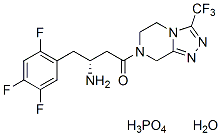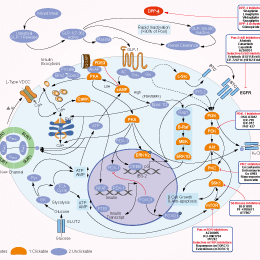
- Bioactive Compounds
- By Signaling Pathways
- PI3K/Akt/mTOR
- Epigenetics
- Methylation
- Immunology & Inflammation
- Protein Tyrosine Kinase
- Angiogenesis
- Apoptosis
- Autophagy
- ER stress & UPR
- JAK/STAT
- MAPK
- Cytoskeletal Signaling
- Cell Cycle
- TGF-beta/Smad
- DNA Damage/DNA Repair
- Compound Libraries
- Popular Compound Libraries
- Customize Library
- Clinical and FDA-approved Related
- Bioactive Compound Libraries
- Inhibitor Related
- Natural Product Related
- Metabolism Related
- Cell Death Related
- By Signaling Pathway
- By Disease
- Anti-infection and Antiviral Related
- Neuronal and Immunology Related
- Fragment and Covalent Related
- FDA-approved Drug Library
- FDA-approved & Passed Phase I Drug Library
- Preclinical/Clinical Compound Library
- Bioactive Compound Library-I
- Bioactive Compound Library-Ⅱ
- Kinase Inhibitor Library
- Express-Pick Library
- Natural Product Library
- Human Endogenous Metabolite Compound Library
- Alkaloid Compound LibraryNew
- Angiogenesis Related compound Library
- Anti-Aging Compound Library
- Anti-alzheimer Disease Compound Library
- Antibiotics compound Library
- Anti-cancer Compound Library
- Anti-cancer Compound Library-Ⅱ
- Anti-cancer Metabolism Compound Library
- Anti-Cardiovascular Disease Compound Library
- Anti-diabetic Compound Library
- Anti-infection Compound Library
- Antioxidant Compound Library
- Anti-parasitic Compound Library
- Antiviral Compound Library
- Apoptosis Compound Library
- Autophagy Compound Library
- Calcium Channel Blocker LibraryNew
- Cambridge Cancer Compound Library
- Carbohydrate Metabolism Compound LibraryNew
- Cell Cycle compound library
- CNS-Penetrant Compound Library
- Covalent Inhibitor Library
- Cytokine Inhibitor LibraryNew
- Cytoskeletal Signaling Pathway Compound Library
- DNA Damage/DNA Repair compound Library
- Drug-like Compound Library
- Endoplasmic Reticulum Stress Compound Library
- Epigenetics Compound Library
- Exosome Secretion Related Compound LibraryNew
- FDA-approved Anticancer Drug LibraryNew
- Ferroptosis Compound Library
- Flavonoid Compound Library
- Fragment Library
- Glutamine Metabolism Compound Library
- Glycolysis Compound Library
- GPCR Compound Library
- Gut Microbial Metabolite Library
- HIF-1 Signaling Pathway Compound Library
- Highly Selective Inhibitor Library
- Histone modification compound library
- HTS Library for Drug Discovery
- Human Hormone Related Compound LibraryNew
- Human Transcription Factor Compound LibraryNew
- Immunology/Inflammation Compound Library
- Inhibitor Library
- Ion Channel Ligand Library
- JAK/STAT compound library
- Lipid Metabolism Compound LibraryNew
- Macrocyclic Compound Library
- MAPK Inhibitor Library
- Medicine Food Homology Compound Library
- Metabolism Compound Library
- Methylation Compound Library
- Mouse Metabolite Compound LibraryNew
- Natural Organic Compound Library
- Neuronal Signaling Compound Library
- NF-κB Signaling Compound Library
- Nucleoside Analogue Library
- Obesity Compound Library
- Oxidative Stress Compound LibraryNew
- Plant Extract Library
- Phenotypic Screening Library
- PI3K/Akt Inhibitor Library
- Protease Inhibitor Library
- Protein-protein Interaction Inhibitor Library
- Pyroptosis Compound Library
- Small Molecule Immuno-Oncology Compound Library
- Mitochondria-Targeted Compound LibraryNew
- Stem Cell Differentiation Compound LibraryNew
- Stem Cell Signaling Compound Library
- Natural Phenol Compound LibraryNew
- Natural Terpenoid Compound LibraryNew
- TGF-beta/Smad compound library
- Traditional Chinese Medicine Library
- Tyrosine Kinase Inhibitor Library
- Ubiquitination Compound Library
-
Cherry Picking
You can personalize your library with chemicals from within Selleck's inventory. Build the right library for your research endeavors by choosing from compounds in all of our available libraries.
Please contact us at info@selleckchem.com to customize your library.
You could select:
- Antibodies
- Bioreagents
- qPCR
- 2x SYBR Green qPCR Master Mix
- 2x SYBR Green qPCR Master Mix(Low ROX)
- 2x SYBR Green qPCR Master Mix(High ROX)
- Protein Assay
- Protein A/G Magnetic Beads for IP
- Anti-Flag magnetic beads
- Anti-Flag Affinity Gel
- Anti-Myc magnetic beads
- Anti-HA magnetic beads
- Poly DYKDDDDK Tag Peptide lyophilized powder
- Protease Inhibitor Cocktail
- Protease Inhibitor Cocktail (EDTA-Free, 100X in DMSO)
- Phosphatase Inhibitor Cocktail (2 Tubes, 100X)
- Cell Biology
- Cell Counting Kit-8 (CCK-8)
- Animal Experiment
- Mouse Direct PCR Kit (For Genotyping)
- New Products
- Contact Us
research use only
Sitagliptin phosphate monohydrate DPP inhibitor
Sitagliptin phosphate monohydrate (MK-0431) is a potent inhibitor of DPP-IV with IC50 of 19 nM in Caco-2 cell extracts.

Chemical Structure
Molecular Weight: 523.32
Purity & Quality Control
Batch:
Purity:
99.88%
99.88
Related Products
| Related Targets | DPP-2 DPP-4 DPP-8 DPP-9 | Click to Expand |
|---|---|---|
| Related Products | Talabostat (PT-100) Omarigliptin (MK-3102) | Click to Expand |
| Related Compound Libraries | Metabolism Compound Library Anti-cancer Metabolism Compound Library Glutamine Metabolism Compound Library Carbohydrate Metabolism Compound Library Lipid Metabolism Compound Library | Click to Expand |
Signaling Pathway
Mechanism of Action
| Features | A potent, orally active inhibitor of DPP-4. | ||
|---|---|---|---|
| Targets |
|
In vitro |
||||
| In vitro | As an orally active agent, Sitagliptin phosphate exhibits a potent inhibitory effect on DPP-4 with IC50 of 19 nM from Caco-2 cell extracts. [1] MK0431 reduces in vitro migration of isolated splenic CD4 T-cells through a pathway involving cAMP/PKA/Rac1 activation. [2] A recent study demonstrates that sitagliptin exerts a novel, direct action in order to stimulate GLP-1 secretion by the intestinal L cell through a DPP-4-independent, protein kinase A- and MEK-ERK1/2-dependent pathway. It therefore reduces the effect of autoimmunity on graft survival. [3] | |||
|---|---|---|---|---|
| Kinase Assay | Plasma DPP-4 Activity[2] | |||
| DPP-4 is extracted from confluent Caco-2 cells. After 5 minutes of incubation at room temperature with lysis buffer (10 mM Tris-HCl, 150 mM NaCl, 0.04 U/mL aprotinin, 0.5% Nonidet P40, pH 8.0), cells are centrifuged at 35,000 g at 4 °C for 30 minutes, and the supernatant is stored at -80°C. Assays are performed by mixing 20 μL of appropriate compound dilutions with 50 μL of the substrate for the DPP-4 enzyme, H-Ala-Pro-7-amido-4-trifluoromethylcoumarin (final concentration in the assay, 100 μM) and 30 μL of the Caco-2 cell extract (diluted 1000-fold with 100 mM Tris-HCl, 100 mM NaCl, pH 7.8). Plates are incubated at room temperature for 1 hour, and fluorescence is measured at excitation/emission wavelengths of 405/535 nm using a SpectraMax GeminiXS. Dissociation kinetics of inhibitors from the DPP-4 enzyme is determined after a 1-hour preincubation of Caco-2 cell extracts with high inhibitor concentrations (30 nM for BI 1356, 3 μM for vildagliptin). The enzymatic reaction is started by adding the substrate H-Ala-Pro-7-amido-4-trifluoromethylcoumarin after a 3000-fold dilution of the preincubation mixture with assay buffer. Under these conditions, the difference in DPP-4 activity at a certain time point in the presence or absence of an inhibitor reflects the amount of this inhibitor still bound to the DPP-4 enzyme. Maximal reaction rates (fluorescence units/seconds × 1000) at 10-minute intervals are calculated using the SoftMax software of the SpectraMax and corrected for the rate of an uninhibited reaction [(vcontrol-vinhibitor)/vcontrol]. | ||||
| Cell Research | Cell lines | CD4 T-cells | ||
| Concentrations | 100 μM | |||
| Incubation Time | 1 hour | |||
| Method | CD4T-cells are plated on membrane inserts in serum-free RPMI 1640, and cell migration is assayed using Transwell chambers (Corning), in the presence or absence of purified porcine kidney DPP-4 (32.1 units/mg; 100 mU/mL final concentration) and DPP-4 inhibitor (100 μM). After 1 hour, cells on the upper surface are removed mechanically, and cells that have migrated into the lower compartment are counted. The extent of migration is expressed relative to the control sample. | |||
In Vivo |
||
| In vivo | In vivo, the ED50 value of Sitagliptin phosphate for inhibition of plasma DPP-4 activity is calculated to be 2.3 mg/kg 7 hour postdose and 30 mg/kg 24 hour postdose in freely fed Han-Wistar rats. [1] The streptozotocin-induced type 1 diabetes mouse model exhibits elevated DPP-4 levels in the plasma that can be substantially inhibited in mice on an Sitagliptin phosphate diet. This is achieved by a positive effect on the regulation of hyperglycemia, potentially through prolongation of islet graft survival. [4] The plasma clearance and volume of distribution of Sitagliptin phosphate are higher in rats (40-48 mL/min/kg, 7-9 L/kg) than in dogs (9 mL/min/kg, 3 L/kg); and its half-life is shorter in rats,2 hours compared with 4 hours in dogs. [5] | |
|---|---|---|
| Animal Research | Animal Models | Freely fed Han-Wistar rats |
| Dosages | ≤10 mg/kg | |
| Administration | Administered via p.o. | |
| NCT Number | Recruitment | Conditions | Sponsor/Collaborators | Start Date | Phases |
|---|---|---|---|---|---|
| NCT05219409 | Not yet recruiting | Type 1 Diabetes |
University of Milan |
July 2023 | Phase 2|Phase 3 |
| NCT05403281 | Completed | Healthy Subjects |
Dong Wha Pharmaceutical Co. Ltd. |
November 5 2021 | Phase 1 |
| NCT03790839 | Completed | Patients |
Hua Medicine Limited |
January 31 2019 | Phase 1 |
| NCT03359590 | Completed | Pharmacological Action |
Profil Institut für Stoffwechselforschung GmbH|Merck Sharp & Dohme LLC |
March 21 2018 | Phase 2 |
References |
|
Chemical Information
| Molecular Weight | 523.32 | Formula | C16H15F6N5O.H3PO4.H2O |
| CAS No. | 654671-77-9 | SDF | Download SDF Download SDF |
| Synonyms | MK-0431 | ||
| Smiles | C1CN2C(=NN=C2C(F)(F)F)CN1C(=O)CC(CC3=CC(=C(C=C3F)F)F)N.O.OP(=O)(O)O | ||
Storage and Stability
| Storage (From the date of receipt) | |||
|
In vitro |
DMSO : 100 mg/mL ( (191.08 mM) Moisture-absorbing DMSO reduces solubility. Please use fresh DMSO.) Water : 41 mg/mL Ethanol : Insoluble |
Molecular Weight Calculator |
|
In vivo Add solvents to the product individually and in order. |
In vivo Formulation Calculator |
|||||
Preparing Stock Solutions
Molarity Calculator
In vivo Formulation Calculator (Clear solution)
Step 1: Enter information below (Recommended: An additional animal making an allowance for loss during the experiment)
mg/kg
g
μL
Step 2: Enter the in vivo formulation (This is only the calculator, not formulation. Please contact us first if there is no in vivo formulation at the solubility Section.)
% DMSO
%
% Tween 80
% ddH2O
%DMSO
%
Calculation results:
Working concentration: mg/ml;
Method for preparing DMSO master liquid: mg drug pre-dissolved in μL DMSO ( Master liquid concentration mg/mL, Please contact us first if the concentration exceeds the DMSO solubility of the batch of drug. )
Method for preparing in vivo formulation: Take μL DMSO master liquid, next addμL PEG300, mix and clarify, next addμL Tween 80, mix and clarify, next add μL ddH2O, mix and clarify.
Method for preparing in vivo formulation: Take μL DMSO master liquid, next add μL Corn oil, mix and clarify.
Note: 1. Please make sure the liquid is clear before adding the next solvent.
2. Be sure to add the solvent(s) in order. You must ensure that the solution obtained, in the previous addition, is a clear solution before proceeding to add the next solvent. Physical methods such
as vortex, ultrasound or hot water bath can be used to aid dissolving.
Tech Support
Answers to questions you may have can be found in the inhibitor handling instructions. Topics include how to prepare stock solutions, how to store inhibitors, and issues that need special attention for cell-based assays and animal experiments.
Tel: +1-832-582-8158 Ext:3
If you have any other enquiries, please leave a message.
* Indicates a Required Field






































